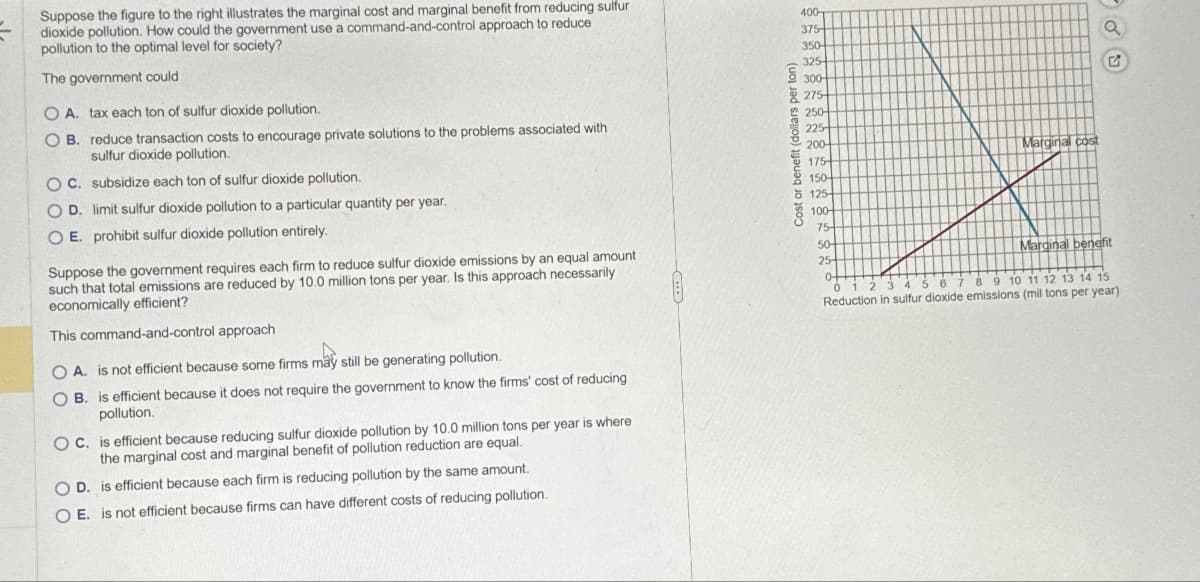Suppose the figure to the right illustrates the marginal cost and marginal benefit from reducing sulfur dioxide pollution. How could the government use a command-and-control approach to reduce pollution to the optimal level for society? The government could O A. tax each ton of sulfur dioxide pollution. OB. reduce transaction costs to encourage private solutions to the problems associated with sulfur dioxide pollution. OC. subsidize each ton of sulfur dioxide pollution. OD. limit sulfur dioxide pollution to a particular quantity per year. OE. prohibit sulfur dioxide pollution entirely. Suppose the government requires each firm to reduce sulfur dioxide emissions by an equal amount such that total emissions are reduced by 10.0 million tons per year. Is this approach necessarily economically efficient? This command-and-control approach OA. is not efficient because some firms may still be generating pollution. OB. is efficient because it does not require the government to know the firms' cost of reducing pollution. OC. is efficient because reducing sulfur dioxide pollution by 10.0 million tons per year is where the marginal cost and marginal benefit of pollution reduction are equal. OD. is efficient because each firm is reducing pollution by the same amount. OE. is not efficient because firms can have different costs of reducing pollution. Cost or benefit (dollars per ton) 400- 375 350- 325 300- 275- 250 225- 200- 175 150+ 126 o 125 100- 75- 50- 25- Marginal cost G Marginal benefit 0- 0 1 2 3 4 5 6 7 8 9 10 11 12 13 14 15 Reduction in sulfur dioxide emissions (mil tons per year)
Suppose the figure to the right illustrates the marginal cost and marginal benefit from reducing sulfur dioxide pollution. How could the government use a command-and-control approach to reduce pollution to the optimal level for society? The government could O A. tax each ton of sulfur dioxide pollution. OB. reduce transaction costs to encourage private solutions to the problems associated with sulfur dioxide pollution. OC. subsidize each ton of sulfur dioxide pollution. OD. limit sulfur dioxide pollution to a particular quantity per year. OE. prohibit sulfur dioxide pollution entirely. Suppose the government requires each firm to reduce sulfur dioxide emissions by an equal amount such that total emissions are reduced by 10.0 million tons per year. Is this approach necessarily economically efficient? This command-and-control approach OA. is not efficient because some firms may still be generating pollution. OB. is efficient because it does not require the government to know the firms' cost of reducing pollution. OC. is efficient because reducing sulfur dioxide pollution by 10.0 million tons per year is where the marginal cost and marginal benefit of pollution reduction are equal. OD. is efficient because each firm is reducing pollution by the same amount. OE. is not efficient because firms can have different costs of reducing pollution. Cost or benefit (dollars per ton) 400- 375 350- 325 300- 275- 250 225- 200- 175 150+ 126 o 125 100- 75- 50- 25- Marginal cost G Marginal benefit 0- 0 1 2 3 4 5 6 7 8 9 10 11 12 13 14 15 Reduction in sulfur dioxide emissions (mil tons per year)
Chapter19: Externalities And Public Goods
Section: Chapter Questions
Problem 19.9P
Related questions
Question
Note: The solution written by hand is not accepted.

Transcribed Image Text:=
Suppose the figure to the right illustrates the marginal cost and marginal benefit from reducing sulfur
dioxide pollution. How could the government use a command-and-control approach to reduce
pollution to the optimal level for society?
The government could
O A. tax each ton of sulfur dioxide pollution.
OB. reduce transaction costs to encourage private solutions to the problems associated with
sulfur dioxide pollution.
OC. subsidize each ton of sulfur dioxide pollution.
OD. limit sulfur dioxide pollution to a particular quantity per year.
O E. prohibit sulfur dioxide pollution entirely.
Suppose the government requires each firm to reduce sulfur dioxide emissions by an equal amount
such that total emissions are reduced by 10.0 million tons per year. Is this approach necessarily
economically efficient?
This command-and-control approach
OA. is not efficient because some firms may still be generating pollution.
OB. is efficient because it does not require the government to know the firms' cost of reducing
pollution.
OC. is efficient because reducing sulfur dioxide pollution by 10.0 million tons per year is where
the marginal cost and marginal benefit of pollution reduction are equal.
O D. is efficient because each firm is reducing pollution by the same amount.
OE. is not efficient because firms can have different costs of reducing pollution.
6
400
375
350-
325
300-
275-
250-
225-
200-
175
150
8 125
100-
75
50-
25-
Marginal cost
Marginal benefit
0-
0 1 2 3 4 5 6 7 8 9 10 11 12 13 14 15
Reduction in sulfur dioxide emissions (mil tons per year)
Expert Solution
This question has been solved!
Explore an expertly crafted, step-by-step solution for a thorough understanding of key concepts.
This is a popular solution!
Trending now
This is a popular solution!
Step by step
Solved in 4 steps

Knowledge Booster
Learn more about
Need a deep-dive on the concept behind this application? Look no further. Learn more about this topic, economics and related others by exploring similar questions and additional content below.Recommended textbooks for you


Principles of Economics, 7th Edition (MindTap Cou…
Economics
ISBN:
9781285165875
Author:
N. Gregory Mankiw
Publisher:
Cengage Learning

Principles of Microeconomics
Economics
ISBN:
9781305156050
Author:
N. Gregory Mankiw
Publisher:
Cengage Learning


Principles of Economics, 7th Edition (MindTap Cou…
Economics
ISBN:
9781285165875
Author:
N. Gregory Mankiw
Publisher:
Cengage Learning

Principles of Microeconomics
Economics
ISBN:
9781305156050
Author:
N. Gregory Mankiw
Publisher:
Cengage Learning

Principles of Economics 2e
Economics
ISBN:
9781947172364
Author:
Steven A. Greenlaw; David Shapiro
Publisher:
OpenStax

Principles of Microeconomics (MindTap Course List)
Economics
ISBN:
9781305971493
Author:
N. Gregory Mankiw
Publisher:
Cengage Learning

Essentials of Economics (MindTap Course List)
Economics
ISBN:
9781337091992
Author:
N. Gregory Mankiw
Publisher:
Cengage Learning